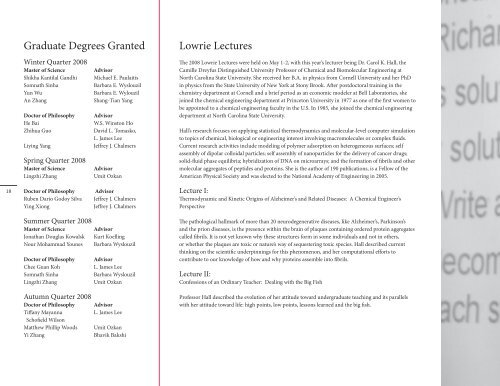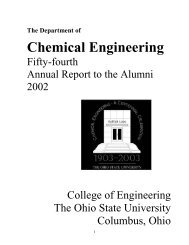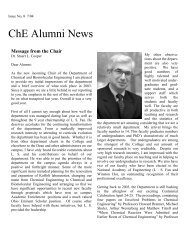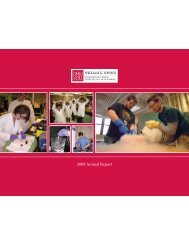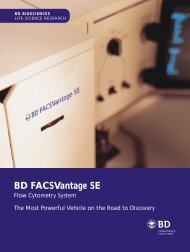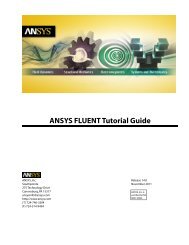2008 Annual Report - Chemical and Biomolecular Engineering ...
2008 Annual Report - Chemical and Biomolecular Engineering ...
2008 Annual Report - Chemical and Biomolecular Engineering ...
Create successful ePaper yourself
Turn your PDF publications into a flip-book with our unique Google optimized e-Paper software.
18<br />
Graduate Degrees Granted<br />
Winter Quarter <strong>2008</strong><br />
Master of Science Advisor<br />
Shikha Kantilal G<strong>and</strong>hi Michael E. Paulaitis<br />
Somnath Sinha Barbara E. Wyslouzil<br />
Yun Wu Barbara E. Wylouzil<br />
An Zhang Shang-Tian Yang<br />
Doctor of Philosophy Advisor<br />
He Bai W.S. Winston Ho<br />
Zhihua Guo David L. Tomasko,<br />
L. James Lee<br />
Liying Yang Jeffrey J. Chalmers<br />
Spring Quarter <strong>2008</strong><br />
Master of Science Advisor<br />
Lingzhi Zhang Umit Ozkan<br />
Doctor of Philosophy Advisor<br />
Ruben Dario Godoy Silva Jeffrey J. Chalmers<br />
Ying Xiong Jeffrey J. Chalmers<br />
Summer Quarter <strong>2008</strong><br />
Master of Science Advisor<br />
Jonathan Douglas Kowalsk Kurt Koelling<br />
Nour Mohammad Younes Barbara Wyslouzil<br />
Doctor of Philosophy Advisor<br />
Chee Guan Koh L. James Lee<br />
Somnath Sinha Barbara Wyslouzil<br />
Lingzhi Zhang Umit Ozkan<br />
Autumn Quarter <strong>2008</strong><br />
Doctor of Philosophy Advisor<br />
Tiffany Mayanna L. James Lee<br />
Schofield Wilson<br />
Matthew Phillip Woods Umit Ozkan<br />
Yi Zhang Bhavik Bakshi<br />
Lowrie Lectures<br />
The <strong>2008</strong> Lowrie Lectures were held on May 1-2, with this year’s lecturer being Dr. Carol K. Hall, the<br />
Camille Dreyfus Distinguished University Professor of <strong>Chemical</strong> <strong>and</strong> <strong>Biomolecular</strong> <strong>Engineering</strong> at<br />
North Carolina State University. She received her B.A. in physics from Cornell University <strong>and</strong> her PhD<br />
in physics from the State University of New York at Stony Brook. After postdoctoral training in the<br />
chemistry department at Cornell <strong>and</strong> a brief period as an economic modeler at Bell Laboratories, she<br />
joined the chemical engineering department at Princeton University in 1977 as one of the first women to<br />
be appointed to a chemical engineering faculty in the U.S. In 1985, she joined the chemical engineering<br />
department at North Carolina State University.<br />
Hall’s research focuses on applying statistical thermodynamics <strong>and</strong> molecular-level computer simulation<br />
to topics of chemical, biological or engineering interest involving macromolecules or complex fluids.<br />
Current research activities include modeling of polymer adsorption on heterogeneous surfaces; self<br />
assembly of dipolar colloidal particles; self assembly of nanoparticles for the delivery of cancer drugs;<br />
solid-fluid phase equilibria; hybridization of DNA on microarrays; <strong>and</strong> the formation of fibrils <strong>and</strong> other<br />
molecular aggregates of peptides <strong>and</strong> proteins. She is the author of 190 publications, is a Fellow of the<br />
American Physical Society <strong>and</strong> was elected to the National Academy of <strong>Engineering</strong> in 2005.<br />
Lecture I:<br />
Thermodynamic <strong>and</strong> Kinetic Origins of Alzheimer’s <strong>and</strong> Related Diseases: A <strong>Chemical</strong> Engineer’s<br />
Perspective<br />
The pathological hallmark of more than 20 neurodegenerative diseases, like Alzheimer’s, Parkinson’s<br />
<strong>and</strong> the prion diseases, is the presence within the brain of plaques containing ordered protein aggregates<br />
called fibrils. It is not yet known why these structures form in some individuals <strong>and</strong> not in others,<br />
or whether the plaques are toxic or nature’s way of sequestering toxic species. Hall described current<br />
thinking on the scientific underpinnings for this phenomenon, <strong>and</strong> her computational efforts to<br />
contribute to our knowledge of how <strong>and</strong> why proteins assemble into fibrils.<br />
Lecture II:<br />
Confessions of an Ordinary Teacher: Dealing with the Big Fish<br />
Professor Hall described the evolution of her attitude toward undergraduate teaching <strong>and</strong> its parallels<br />
with her attitude toward life: high points, low points, lessons learned <strong>and</strong> the big fish.


